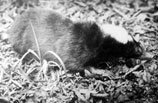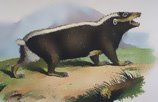Animal of the Week April 25, 2005 -- Nautilus
 Hello Animal Freaks!
Hello Animal Freaks!This weeks animal of the week is Nautilus pompilius (chambered nautilus). I thought it was about time we had a cephalopod is all. There are seven species of extant nautiloids today in two genera (Nautilus and Allonautilus). N pompilius is one of the more common species, but even so, little is known about these animals. During the ordovician era (510-420 million years ago) nautiloids were very common in the oceans and the species much more diverse -- some had shells up to 1·5 m across. Nautiloids clung on to the present day unlike their not dissimilar cousins, ammonites (the spiral-shell fossil things that crop up everywhere), but their time was passed and other cephalopods without external shells (tasty ones like squid and octopus [licks lips]) have become much more prominent. Nautiluses live only in the western pacific, swim slowly, breed slowly, and are pretty, all of which puts them in danger of exploitation. Do you remember making pinhole cameras in school, nautiluses have pinhole-camera-like eyes with no lens -- their eyes are filled with sea water.
See a Russian rock group called Nautilus pompilius http://www.nautilus.ru/




